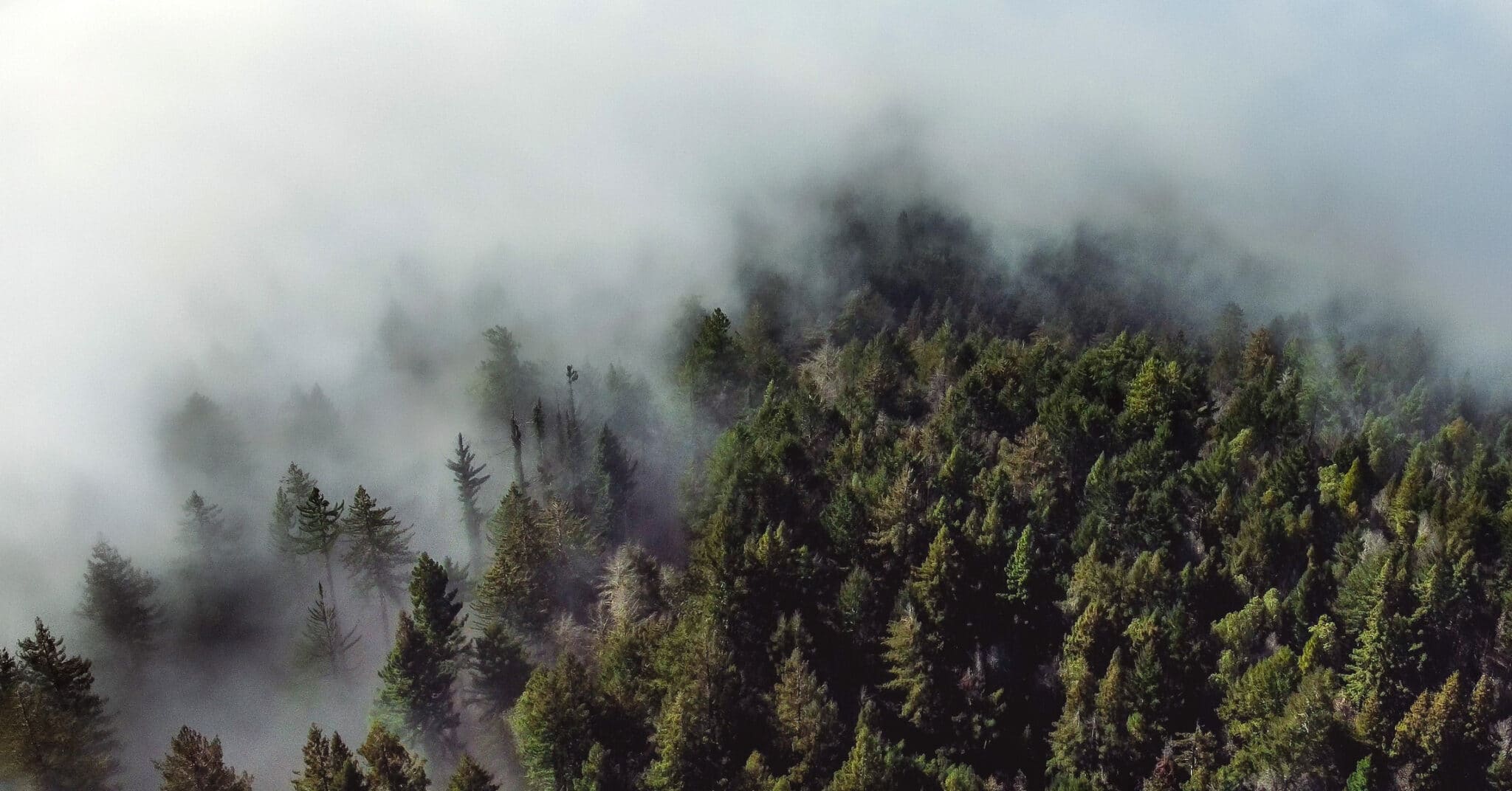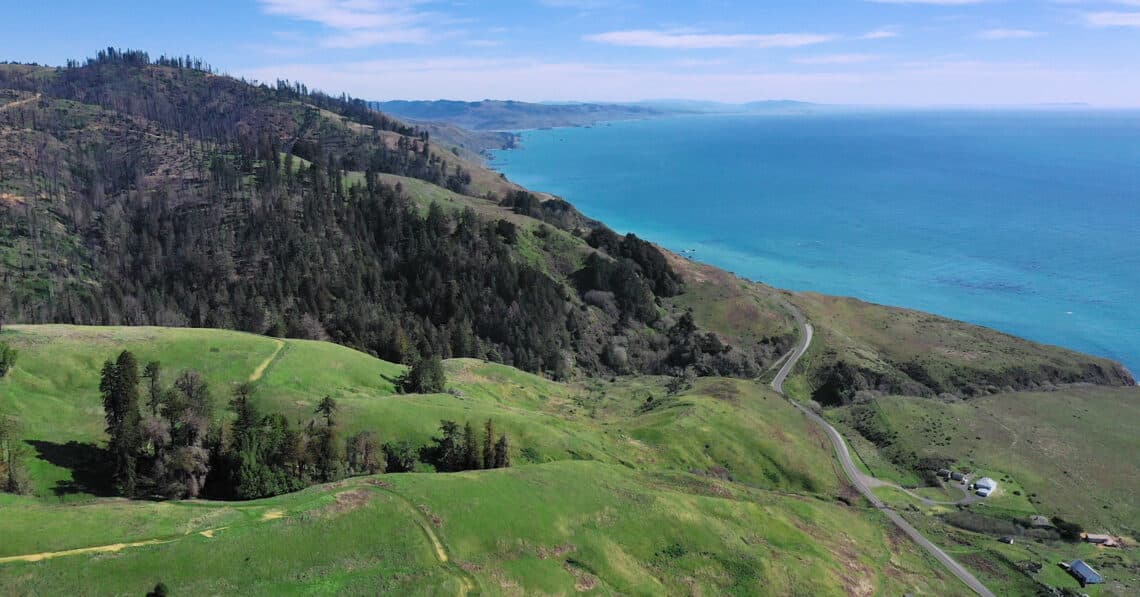Help protect an iconic redwood landscape along California’s rugged coast
Standing on the Sonoma Coast Redwoods property, your eyes are immediately drawn to the infinite horizon. Panoramic views take in historic Fort Ross to the north and Jenner, Bodega Bay, and Point Reyes to the south—a sinuous coastline fronted by a shimmering expanse of Pacific Ocean. As you gaze out at the waves, the sounds of the Northern California coast soon emerge: the distant barking of sea lions, the screech of a red-tailed hawk, the hum of wind across golden prairie, the hushed rustle of towering redwood trees.
There are certainly those who would love to build homes and private estates up here, just two hours from San Francisco, near secluded beaches, the Russian River, and Sonoma’s wine country. But Save the Redwoods League and our partners have other plans. Together, we intend to acquire, restore, and permanently protect this 1,624-acre property—one of a treasured few of its kind—for the benefit of all.
Right now, we have a window of opportunity. Collectively, we can preserve the property’s cultural value as the ancestral home of the Kashia people. We can reconnect wildlife habitat and build resilience to mega-fires and climate change. And we can secure an extraordinary redwood landscape for the enjoyment of future visitors and the health and well-being of the 2 million people who live near this spectacular place.
What’s at stake
- 1,624 acres, roughly twice the size of Central Park
- 836 acres of coast redwood forest, including some of California’s oldest second-growth trees and scattered old growth up to 1,000 years in age
- Stands of young redwoods that will store large amounts of planet-warming carbon as they grow
- Biodiverse habitat for native plant and animal species, including Northern spotted owl, Sonoma tree vole, and Sonoma spineflower
- Ancestral territory of the Kashia Band of Pomo Indians, who own and steward the nearby Kashia Coastal Reserve
- Greater fire resilience and a buffer for the redwood forest at adjacent Fort Ross State Historic Park
- Expanded opportunities for public recreation, including a potential extension of the California Coastal Trail
Reconnecting Sonoma’s redwood corridor


For millennia, coast redwoods defined the Sonoma landscape. Fog-shrouded forests blanketed the coastal bluffs, while some of the tallest trees on the planet flourished in the rich soil of the Russian River floodplain. Many of these giants were lost in the California timber rush and ensuing harvests. But stunning pockets of old growth remain, along with resilient second-growth forests eager to reach the sky once more.
Acre by acre, Save the Redwoods League and our partners are resurrecting these legendary redwoods. Already we have permanently protected nearly 20 square miles in Sonoma County, including the addition of 2,157 acres to Fort Ross State Historic Park—an expansion that nearly tripled the park’s size—and helping to acquire 5,630 acres to create Jenner Headlands Preserve.
Sonoma Coast Redwoods represents a key puzzle piece in this effort to secure the region’s redwood footprint. The property contains 836 acres of coast redwood forest, much of which has been in timber production for more than a century. As a result, the second-growth trees here are of varying ages, including scattered old-growth giants potentially as old as 1,000 years. This variety indicates a healthy recovering forest—the kind where young trees can grow quickly and pack away large amounts of carbon when the planet needs it most.
Safeguarding these resilient redwoods will set them on a trajectory toward becoming big, old-growth trees that support the highest biodiversity and sequester the most carbon. Protecting this sizeable parcel aligns with the League’s centennial vision to double the amount of coast redwood forests in parks and reserves to 800,000 acres. It will also advance California’s 30×30 plan to protect 30% of the state’s land and coastal waters by 2030 to help fight climate change and support biodiversity.
Expanding habitat for wildlife to flourish


Within this landscape, a vibrant coast redwood forest meets sweeping ridgetop meadows where butterflies flit between flowers and deer wander in the grass. Safeguarding this stunning haven for native plants and animals, many of them rare or endangered, is a priority. The acquisition would connect more than 7.8 square miles of wildlife habitat and nearly 8 miles of streams, including a redwood-lined stretch of Fort Ross Creek where steelhead return from the ocean to spawn.
Raptors such as golden eagles, bald eagles, and red-tailed hawks are regularly seen riding the thermals above the property’s steep bluffs. There is also abundant owl habitat, with three Northern spotted owl activity centers within less than a mile of the property. Several other wildlife species of special concern dwell on the property, including California giant salamander, foothill yellow-legged frog, and Sonoma tree vole.
In spring, wildflowers blanket the property’s green meadows, home to colorful marsh pea, woolly-headed gilia, and rare Sonoma spineflower, a species once thought to be extinct. California’s coastal prairies are some of the most biodiverse grasslands in North America—and one of the most threatened due to development, invasive species, and fire exclusion. The grasslands at Sonoma Coast Redwoods, which have long been used for livestock grazing, possess enormous potential for restoration.
Protecting a vital past and bright future

In addition to its ecological richness, Sonoma Coast Redwoods possesses a historical and cultural significance that’s essential to protect. The property lies within the ancestral territory of the Kashia Band of Pomo Indians, who own and steward the nearby Kashia Coastal Reserve and maintain deep cultural ties to these lands.
The present-day Kashia reservation, Stewarts Point Rancheria, represents only a small portion of the tribe’s ancestral territory, which extends from the Pacific Ocean north to the Gualala River, inland to the confluence of Warm Spring Creek and Dry Creek, and south beyond the Russian River to Duncan’s Point. The Kashia people have stewarded this land for millennia; and prior to European contact, an estimated 1,500 people inhabited this territory.

Russian emissaries reached the Sonoma Coast in the early 1800s, looking to expand the fur trade and provision their settlements in Alaska. In 1812, the Russian-American Company established Fort Ross and began farming portions of what is now the Sonoma Coast Redwoods property, employing the Kashia for labor. At that time, this was the site of the first non-Indigenous commercial logging of redwoods in California.
By 1841, the Russians had concluded their California experiment, leaving behind a historic orchard, a cemetery, and the landmark redwood structures that make Fort Ross State Historic Park a popular visitor destination today.
With Fort Ross immediately north of Sonoma Coast Redwoods, protection of the property would help buffer the state park’s redwood forest and create the potential to extend the California Coastal Trail through breathtaking scenery. This would be a truly unique opportunity to expand equitable public access along the Sonoma coast and connect more people with inspiring outdoor experiences that benefit their health and well-being.
Next steps toward permanent protection

While the vision for Sonoma Coast Redwoods is clear and bright, the future of this iconic stretch of California coast is yet to be determined.
Our immediate goal is to raise the necessary funds to secure the redwood forest footprint against the threat of development, timber harvest, and wildfire. If the League succeeds in acquiring Sonoma Coast Redwoods with the help of our supporters, we intend to transfer this land to public ownership, in line with our goal of increasing the number of stunning redwood destinations that are accessible to all.
We are currently engaging with prospective tribal, parks, and funding partners to determine a permanent steward and ensure that the property’s extraordinary cultural, conservation, and climate resources are forever preserved. This is a collective opportunity—a chance to be good ancestors and ensure that the beauty and benefits of this magnificent landscape stretch far into the future.

Frequently Asked Questions
Newsroom
PRESS RELEASE
- September 12, 2024 — Save the Redwoods League Secures Opportunity to Protect and Restore 1,600+ Acres of Redwood Forest and Coastal Prairies from Threat of Development along Sonoma Coast
For media inquiries, contact Robin Carr at (415) 766-0927 or redwoods@landispr.com.
To access hi-res images, b-roll or drone footage of the Sonoma Coast Redwoods, please visit our media resources.
NEWS COVERAGE
- Press Democrat: Save The Redwoods League seeks to buy, restore 1,624-acre Sonoma Coast timber property abutting Fort Ross State Historic Park
September 2024 - The Mercury News: Three miles of scenic Northern California coastline preserved in major redwoods deal
September 2024 - SF Chronicle: California Coastal Trail could get extension through Sonoma preservation deal
September 2024
Ways to get involved
Donate TodayConsider a gift to support the Sonoma Coast Redwoods
Tags: 2024, current, Kashia Band of Pomo Indians, land acquisition, land deals, Land Project, Protect, Sonoma Coast Redwoods, Sonoma County
